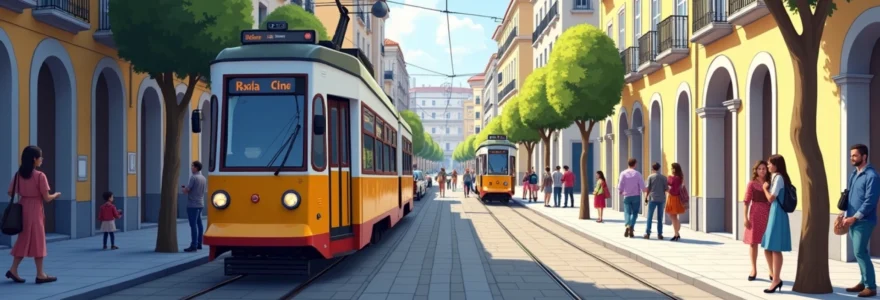Exploring the cobblestone streets and ancient architecture of Europe’s historic cities is a dream for many travellers. While walking tours and bus rides have long been popular options, there’s a unique and charming way to experience these urban treasures: by tram. These iconic rail vehicles offer a perfect blend of nostalgia and practicality, allowing visitors to traverse centuries-old neighbourhoods with ease and style.
Trams provide an unparalleled vantage point for sightseeing, offering panoramic views of city landmarks while gliding effortlessly through narrow streets. They serve as both a means of transportation and a cultural experience, immersing passengers in the daily rhythms of local life. Moreover, tram networks often reach areas inaccessible to larger vehicles, enabling tourists to discover hidden gems off the beaten path.
Tram network infrastructure in historic european cities
The tram networks in Europe’s historic cities are marvels of urban planning and engineering. These systems have evolved over decades, often centuries, to seamlessly integrate with the urban fabric. In many cases, tram lines predate the automobile, shaping the growth and development of cities around them.
Modern tram infrastructure blends cutting-edge technology with preservation of historical elements. Many cities have invested in upgrading their networks while maintaining the charm of vintage trams on select routes. This dual approach ensures efficient transportation while preserving the nostalgic appeal that attracts tourists.
One of the most impressive aspects of tram networks in historic cities is their ability to navigate tight spaces. Engineers have developed innovative solutions to allow trams to traverse narrow medieval streets without compromising the integrity of centuries-old buildings. This feat of urban design enables visitors to experience the heart of old town centres in a way that would be impossible with larger vehicles.
Energy efficiency and sustainability of tram systems
Trams are at the forefront of sustainable urban transport, offering significant environmental benefits compared to other modes of transportation. Electric-powered trams produce zero direct emissions, contributing to improved air quality in city centres. This is particularly crucial in historic areas where pollution can damage ancient stonework and facades.
The energy efficiency of trams is remarkable. A single tram can transport hundreds of passengers, replacing dozens of cars or several buses. This reduces overall energy consumption and alleviates traffic congestion, a common issue in tourist-heavy historic districts. Additionally, many modern tram systems incorporate regenerative braking, which recovers energy during deceleration and feeds it back into the power grid.
Sustainability extends beyond just energy use. Tram infrastructure has a long lifespan, with many components lasting decades. This longevity reduces the need for frequent replacements and minimises waste. Furthermore, the fixed nature of tram routes encourages transit-oriented development, promoting compact, walkable urban spaces that align well with the layout of historic city centres.
Integrating trams with urban heritage preservation
The challenge of integrating modern tram systems into historic urban environments requires a delicate balance between progress and preservation. City planners and conservationists work in tandem to ensure that tram infrastructure complements rather than detracts from the cultural heritage of these iconic locations.
Case study: lisbon’s iconic yellow trams
Lisbon’s famous yellow trams are a prime example of successful integration of public transport with urban heritage. These vintage eléctricos have been navigating the city’s steep hills and narrow streets since the late 19th century. Today, they serve as both a practical means of transportation and a beloved tourist attraction, offering scenic routes through the city’s most historic neighbourhoods.
The preservation of Lisbon’s tram network goes beyond maintaining the vehicles themselves. The city has carefully preserved the traditional track layout and overhead wire systems, ensuring that the overall streetscape remains authentic. This commitment to heritage has made Lisbon’s trams an integral part of the city’s cultural identity and a must-experience attraction for visitors.
Adapting tram routes to narrow medieval streets
Many European cities face the challenge of running tram lines through streets that were laid out centuries before the advent of motorised transport. Innovative solutions have been developed to address this, including:
- Custom-designed narrow-gauge trams that can navigate tight turns
- Single-track sections with passing loops to allow bidirectional travel
- Advanced track systems that minimise vibrations and protect historic buildings
- Cleverly positioned stops that avoid obstructing narrow thoroughfares
These adaptations allow trams to serve areas that would otherwise be cut off from efficient public transport, enhancing accessibility for both residents and tourists exploring the historic core of the city.
Noise reduction techniques in UNESCO world heritage sites
Preserving the tranquil atmosphere of historic districts is crucial, especially in UNESCO World Heritage Sites. Tram operators have implemented various noise reduction techniques to minimise disruption:
- Low-floor trams with improved suspension systems
- Continuous welded rails to reduce clickety-clack sounds
- Acoustic barriers and vibration-dampening track beds
- Speed restrictions in sensitive areas
These measures ensure that trams can operate without compromising the peaceful ambiance that is often a key part of the historic city experience.
Visual integration of modern trams in historic landscapes
The visual impact of tram infrastructure on historic cityscapes is a key consideration. Designers have developed creative solutions to blend modern trams with their surroundings:
- Colour schemes that complement local architecture
- Sleek, low-profile designs that don’t obstruct views
- Integration of stops with existing street furniture
- Use of traditional materials for tram shelters and information displays
By carefully considering aesthetics, cities can ensure that their tram systems enhance rather than detract from the visual appeal of historic areas.
Accessibility and mobility enhancement for tourists
Trams play a crucial role in enhancing accessibility for tourists exploring historic European cities. These rail systems offer a level of convenience and ease of use that can significantly improve the visitor experience, especially for those with mobility challenges or limited time.
Barrier-free tram design for inclusive tourism
Modern tram systems are designed with inclusivity in mind, featuring:
- Low-floor entrances for step-free access
- Wide doors and spacious interiors to accommodate wheelchairs and pushchairs
- Visual and audio announcements for stops and transfers
- Tactile guidance systems for visually impaired passengers
These features ensure that trams are accessible to all visitors, regardless of age or physical ability, allowing everyone to enjoy the historic sights comfortably.
Multi-language information systems on trams
To cater to international visitors, many tram networks have implemented multi-language information systems. These typically include:
- Digital displays showing route information in multiple languages
- Audio announcements in the local language and English
- QR codes linking to translated route maps and tourist information
- Multilingual staff on board or at major stops to assist tourists
These systems help break down language barriers, making it easier for tourists to navigate unfamiliar cities with confidence.
Integration with Bike-Sharing and pedestrian zones
Many European cities have seamlessly integrated their tram networks with other sustainable transport options:
- Tram stops located near bike-sharing stations for easy transfers
- Dedicated spaces on trams for bicycle storage
- Tram lines that connect major pedestrian zones
- Integrated ticketing systems for trams, bikes, and other public transport
This integration allows tourists to combine different modes of transport easily, creating flexible and enjoyable sightseeing experiences.
Tram-based sightseeing tours and cultural experiences
Trams offer a unique platform for specialised sightseeing tours and cultural experiences. Many cities have capitalised on the charm and convenience of their tram networks to create memorable tourist offerings.
Audio-guided heritage routes on prague’s tram line 22
Prague’s Tram Line 22 is renowned for its scenic route through the city’s historic centre. The city has enhanced this experience by offering audio-guided tours:
- Passengers receive headsets with GPS-triggered commentary
- The narration covers historical facts, architectural highlights, and local legends
- Multiple language options are available to cater to international visitors
- The tour can be enjoyed as part of a regular tram journey, blending sightseeing with practical transport
This innovative approach turns a simple tram ride into an immersive cultural experience, allowing tourists to gain deeper insights into Prague’s rich history and heritage.
Thematic trams: art nouveau tour in budapest
Budapest has embraced the concept of themed tram tours, with a particular focus on its Art Nouveau heritage. The city operates special Art Nouveau trams that feature:
- Interiors decorated in the style of early 20th-century trams
- Guided tours highlighting Art Nouveau architecture along the route
- Stops at key Art Nouveau sites with time for photos and exploration
- Complementary informational materials about the Art Nouveau movement in Budapest
These themed tours provide a unique way to explore a specific aspect of the city’s cultural heritage, appealing to architecture enthusiasts and history buffs alike.
Gastronomic tram experiences in bordeaux wine country
Bordeaux has taken the concept of tram-based experiences to new heights with its gastronomic tram tours. These culinary journeys combine sightseeing with local food and wine tasting:
- Specially outfitted trams with dining tables and wine-tasting stations
- Routes that pass through scenic vineyards and historic wine-producing areas
- On-board sommeliers offering insights into Bordeaux’s wine heritage
- Stops at local producers for tastings and to purchase regional specialities
This innovative approach showcases how trams can be used to create truly unique and memorable tourist experiences that go beyond simple transportation.
Smart ticketing and digital integration for seamless exploration
The advent of smart ticketing systems and digital integration has revolutionised the way tourists can use trams to explore historic European cities. These technological advancements have made it easier than ever for visitors to navigate unfamiliar transit systems and make the most of their time in the city.
Many cities now offer contactless payment options, allowing tourists to use their credit cards or mobile devices to pay for tram rides directly. This eliminates the need to purchase and carry physical tickets, streamlining the travel experience. Some cities have gone a step further, implementing capped fares that automatically calculate the best value for a day’s travel, ensuring tourists never pay more than necessary.
Digital integration extends beyond payment systems. Many tram networks now offer real-time tracking through mobile apps, allowing passengers to see exactly when the next tram will arrive. These apps often include journey planners that combine tram routes with other forms of public transport, helping tourists efficiently plan their sightseeing itineraries.
Some cities have introduced gamification elements to their tram systems, creating digital scavenger hunts or augmented reality experiences tied to tram routes. These innovative approaches turn a simple tram ride into an interactive adventure, encouraging tourists to explore different parts of the city and learn about its history in a fun, engaging way.
The integration of trams with IoT (Internet of Things) technology is paving the way for even more advanced features. Sensors on trams and at stops can provide real-time data on passenger numbers, allowing tourists to choose less crowded services. Some cities are experimenting with personalised notifications that alert tourists to nearby attractions or events as they travel on trams, further enhancing the exploration experience.
As these technologies continue to evolve, the role of trams in tourist exploration is likely to expand. From seamless ticketing to interactive guided tours, the humble tram is being transformed into a powerful tool for discovering the hidden treasures of Europe’s historic cities.


